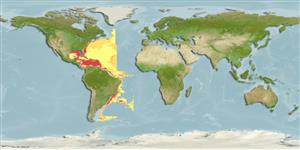>
Trachichthyiformes (Roughies) >
Trachichthyidae (Slimeheads)
Etymology: Hoplostethus: Greek, hoplon = weapon + Greek, stetho, stethion = brest; literal = to prick a little breast (Ref. 45335).
Environment: milieu / climate zone / depth range / distribution range
Ecologia
marino batipelagico; distribuzione batimetrica 485 - 550 m (Ref. 9869). Deep-water
Atlantic Ocean: southern Nova Scotia south to the northern part of the Gulf of Mexico, on the eastern seaboard of Florida, in the Bahama, in the west and southern Caribbean, and around Venezuela, Guyana, Suriname, Tobago and Brazil.
Size / Peso / Age
Maturity: Lm ? range ? - ? cm
Max length : 17.3 cm SL maschio/sesso non determinato; (Ref. 37108)
Spine dorsali (totale) : 6; Raggi dorsali molli (totale) : 13; Spine anali: 3; Raggi anali molli: 9. Pectoral fin long, its tip extending beyond anal fin origin (Ref. 13608). Scales adherent, spinules small, margins serrate, spines on fin rays small. Denticles on head bones small, septae relatively strong (Ref. 37108).
Life cycle and mating behavior
Maturità | Riproduzione | Deposizione | Uova | Fecundity | Larve
Kotlyar, A.N., 1986. Systematics and distribution of species of the genus Hoplostethus Cuvier (Beryciformes, Trachichthyidae). Trudy Inst. Okeanol. 121:97-140. (Ref. 9869)
IUCN Red List Status (Ref. 130435: Version 2024-1)
Threat to humans
Harmless
Human uses
Pesca: di nessun interesse
Strumenti
Special reports
Download XML
Fonti Internet
Estimates based on models
Preferred temperature (Ref.
123201): 8.3 - 13.5, mean 9.4 °C (based on 21 cells).
Phylogenetic diversity index (Ref.
82804): PD
50 = 0.5000 [Uniqueness, from 0.5 = low to 2.0 = high].
Bayesian length-weight: a=0.01660 (0.00714 - 0.03859), b=3.05 (2.85 - 3.25), in cm total length, based on LWR estimates for this (Sub)family-body shape (Ref.
93245).
Trophic level (Ref.
69278): 3.6 ±0.59 se; based on food items.
Resilienza (Ref.
120179): Molto basso, tempo minimo di raddoppiamento della popolazione più di 14 anni (Preliminary K or Fecundity.).
Fishing Vulnerability (Ref.
59153): Low vulnerability (11 of 100).
